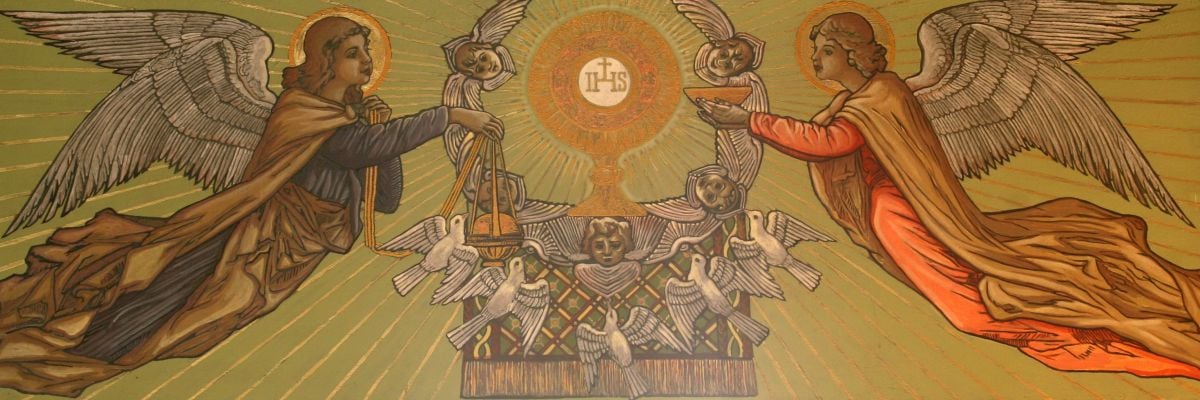
Homily for Corpus Christi Sunday, Year A
Why did our Savior give us the sacrament of his body and blood?
First of all, so that we would be able to offer—throughout time until he comes again on the last day—the same sacrifice he offered on the wood of the cross, so that the same fruits of his saving offering should be applied to the souls of Christ’s members each day and in every age.
We were not to repeat this sacrifice in its natural, “bloody” offering, however, but under signs of bread and wine as both sacrifice and spiritual food. Our Lord first offered his body and blood under these signs at the Last Supper, even before he offered them in their natural forms and appearances in his Passion. Thus the Mass is not only Calvary: it is a repetition of what the Lord did at the Last Supper in the Cenacle on Mount Sion in Jerusalem on the night before he suffered.
From the beginning, then, it has been clear that Jesus did not want his cross to be without the Mass, without its perpetual presence and memory in the Holy Eucharist. Thus we “proclaim the death of the Lord Jesus until he comes,” as the apostle teaches us.
But for all this to be a reality, a marvel has to be accomplished: the marvel we call the real presence, the result of the change of the bread and wine we offer into the very things they symbolize, namely the body and blood of the Lord Jesus—born of the Virgin Mary, crucified for us, and now risen and seated at the right hand of the Father in heaven.
This is the “mystery of faith” we profess and adore and receive. The very same body and blood of the Lord present in one heavenly place in his natural dimensions is also really and substantially present wherever the sacrament is present. This is a marvel beyond the comprehension of any mind, human or angelic. What it means is that there is a hidden and mysterious proportion between the natural body and blood of the Lord and the Eucharist on our altars such that wherever the sacred appearances of bread and wine are there, he is there as truly as any of us are physically present to each other.
And what is more, since he is not divided, but is the one Christ, wherever his body is, there is his blood; and wherever they are, there are also his human soul and his eternal Godhead: body, blood, soul and divinity.
The Blessed Sacrament is a symbol, but of a very perfect and intense kind. It is not a mere symbol, but actually contains the things it symbolizes. It is the body and blood of the Lord, it is the sacrifice of the same body and blood. Bread and wine are no more, but only their outward appearances in the place occupied by their sensible forms.
Our faith in this mystery is most of all in the infinitely sublime manner in which the natural body and blood of the Lord is identical with the body and blood conveyed in the Eucharist. Heaven on earth, heaven on our altars, heaven in our souls and bodies! This marvelous “proportion” between the visible Lord in heaven and these mere signs on earth is the mystery we cannot see, but in which we believe in this mystery of faith.
This leads us to the how of this mystery of faith. This is something we cannot see, something that belongs to the hidden wisdom of God. His wisdom is his love ordering all things strongly and sweetly and joining all into one, uniting end to end. This wise love always goes out and returns to its source. Our Lord never worked a marvel or a miracle just to make a show. He worked his wonders to reward or to create faith and love in his followers. This we see throughout the Gospels.
First of all, we are told by the Lord that just as he has life from all eternity from the Father, so the one who feeds on him will have life because of him and he will raise him up on the last day. The blessed Eucharist gives us a share in the life of the Holy Trinity, in the eternal sonship from the Father shown forth in our glorious resurrection.
It is the work of love to attract and to bestow what is good. This drawing and giving works between two extremes: humility and love. God’s love looked upon the humility of Mary and by her humble faith he took to himself our human nature. This was the humility of God in becoming a little infant, the humility of her of whom it was said, “Blessed is she who has believed.” It was the humility of the crucified becoming present under the merest humble appearances of bread and wine and dwelling in our very bodies formed from the dust of the earth.
Here we find the secret of the marvelous proportion between the Lord’s glorious body in heaven and the sacramental symbols: the work of loving humility and humble love. Where do we find this most clearly but in Mary, the mother of the Savior incarnate from her own flesh and blood? The mystery of Mary’s divine motherhood holds the unseen key to this proportion. Her humility and love are the instruments of a supremely divine power uniting end to end in the wise working of this most blessed sacrament.
This is why we always find a burning devotion to Our Lady wherever we find devotion to the Eucharistic presence. It will be our great joy in heaven to see just how it was that the humility of Jesus and his mother are the foundation and cause of the greatest of their miracles.
If we are humble and loving, full of faith and charity, we will begin to share in this mystery as we ought, and will be fit to adore and offer up and receive the most holy body and blood of the Lord. Mary, says the great Greek theologian St. Gregory Palamas, is the frontier between created and uncreated nature. So it will be in the vision of blessedness, that we will come to see how Mary and Jesus bring about this mystery that we celebrate daily until the end of the age.
Such a sight is well worth the wait as from this altar we await the Blessed Hope and the Coming of our Savior, Jesus Christ. He is coming, she is near at hand, right here in this place and in the highest heaven for ages unending. Amen!



